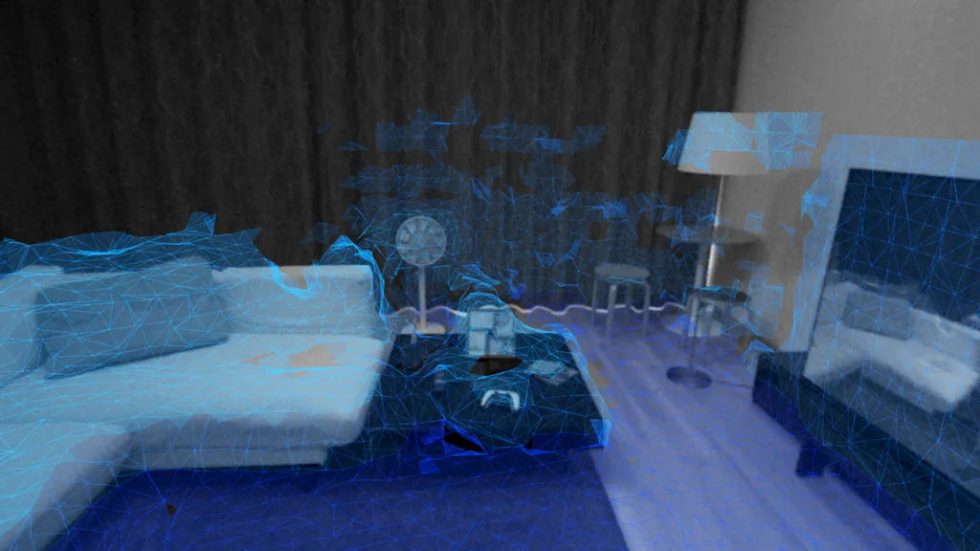
Ahead of Sony's arrival at this weekend's 2022 Tokyo Games Show, the company's PlayStation division pushed a bunch of online news to fans over the past 24 hours. The biggest news arguably came from hands-on and eyes-on impressions of its PlayStation VR2 add-on for the PS5 console.
The new virtual reality system, slated for an "early 2023" retail launch, is now being talked about outside Sony's careful public relations hands, and its earliest testers have offered impressions of both the hardware and some of its apparent launch software.
PSVR2: What we already knew
-
Say so long to the original PSVR's glowing blue lights.
-
While prototype PSVR2 controllers have been all black, they now match the white of the PS5 itself.
-
A side view highlights the headband and hanging scope design.
Thanks to Sony's announcements from earlier this year, we know that PSVR2's OLED display packs a pixel resolution of 4000×2040, which can run VR software in either 90 Hz or 120 Hz modes. That performance is boosted by a new foveated rendering system, which is meant to emphasize full pixel resolution where your eyes are focused and blur the parts where your eyes are not—and this, unsurprisingly, is coupled with new internal eye-tracking sensors.
We also know that PSVR 2 will ship with two entirely new gamepads, one for each hand, that follow the Meta Quest archetype of VR controllers (complete with buttons, triggers, and joysticks) but with the additional tech upgrades found in Sony's recent DualSense gamepads—namely, more refined rumbles and tension-filled "impulse" triggers.
A new "inside-out" tracking system resembles the kind found in Meta Quest and various Windows Mixed Reality headsets, and this uses built-in cameras to scan players' real-world environs and track VR positioning, no external cameras or tracking boxes required. However, unlike the wireless-by-default Meta Quest 2, PSVR2 requires a cable connection for power and data transfer to a PlayStation 5 console.
PSVR2 hardware: What we’ve learned this week
Speaking of that cable connection: We've now seen it in action. The new single-cable connection, via PS5's sole USB Type-C slot, is a revelation compared to the external, cables-everywhere "processor unit" required for Sony's first VR system. This 4.5-meter cable has reportedly been designed to weigh as little as possible, but a cable that can wrap around your legs may remain a deal-breaker for some.
Sony also confirmed that PSVR would lack built-in audio. Just like the last model, PSVR2 owners will need to connect headphones using a 3.5 mm jack. The original PSVR shipped with low-budget earbuds, which may happen again for PSVR2—and to Sony's credit, the new headset includes nifty, built-in "earbud plugs" that you can squish your existing earbuds into to tidily store them. But this is a bummer compared to the built-in audio found in Valve Index and all Meta Quest models. This week's demonstration videos show that Sony's larger, PS-branded headphones constrain users in VR, reduce airflow, and leave people sweaty, so interested users should look into high-quality, lightweight wired earbuds ahead of PSVR2's 2023 launch. (My 3.5 mm recommendation is the affordable, high-performing Koss KSC32-i.)
In better news, Sony's lens mechanism includes a precise interpupillary distance (IPD) slider, which can be accessed with a handy dial while the system is attached to the face. (This is a huge differentiator from Quest 2, which skipped such a slider as a cost-saving measure.) New users can access a handy calibration menu at any time to make sure the IPD setting is aligned to their unique face, and this additionally asks users to glance at an array of moving dots to calibrate PSVR2's eye-tracking sensors. So far, PSVR2's "hovering" fit, complete with a foam backstrap and nifty dial to tighten the fit, resembles the same one that we loved in the original PSVR. The fit around the eyes is reportedly spacious enough for glasses wearers, though we're still waiting to hear about the new system's weight and distribution compared to the original—at least, beyond suggestions that the current headset is quite light.

PSVR2's new room-tracking system, which relies on four built-in cameras, appears to automatically account for objects in your gaming space. When users aim the system's cameras at a new room, the black-and-white passthrough view coats objects (furniture, entertainment centers) in a trippy pattern of 3D triangles as the PSVR2 cameras scan over them, instead of making users aim their hands to scan and "paint" a play space. If PSVR2 gets it wrong, users can still use the system's controllers to fine-tune their VR "boundary" before they begin playing. The headset includes a button on its bottom that can enable PSVR2's passthrough camera mode at any time so that users can see what's around them without removing the headset.
We previously learned that PSVR2 includes an array of built-in rumbling motors—a first in consumer-grade VR—and now we know how they work in action. The rumble's severity can vary between a subtle sensation, like when flies buzz about your face during a sequence in Resident Evil: Village VR, or a more intense full-head blast, like when a monster flies above your head and sends a gust of wind toward you in Horizon VR: Call of the Mountain. So far, reports suggest that this sensation is more immersive than it is obnoxious.
Sony has not yet confirmed the maximum brightness of its OLED display, simply suggesting that it is rated for "HDR," but Sony is clearly taking screen quality and light bleed seriously. OLED panels are generally better at managing an "infinite" contrast ratio, thus putting deepest blacks and brightest lights side by side, and PSVR2 apparently includes a superior light-blocking arrangement of foam and nose liners.
reader comments
79